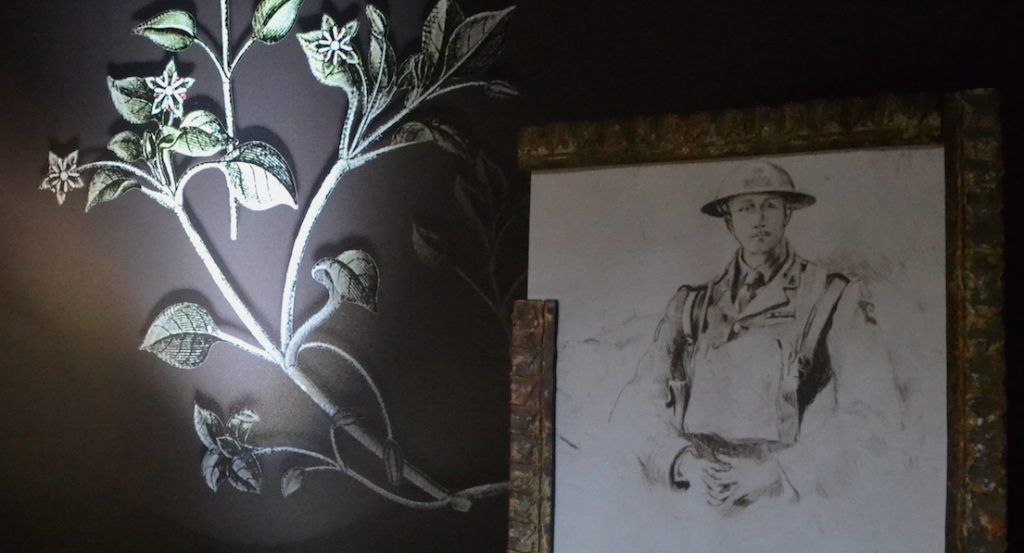Art exhibit honours Canadian soldier’s bond with family
By Lia Pizarro
More than 100 years after the beginning of the First World War, the story of a Canadian soldier’s love for his daughter — along with the flowers he sent home to her — have inspired the creation of a touring art exhibition called WAR Flowers.
The exhibition was curated and developed by Viveka Melki and les Jardins de Métis/Reford Gardens in Grand-Métis, Que., with the first stop of the tour taking place at the garden.
Now on display at the Canadian War Museum, the exhibition consists of multi-sensory displays that tell the history of conflict, sacrifice and perseverance, as well as the stories and experiences of Canadian men and women whose lives were touched by the First World War.
Melki dedicated the past four years of her life to tell the story of George Stephen Cantlie, the Canadian soldier from Montreal who picked flowers from the fields and gardens of a then war-torn Europe to send home to his baby daughter, Celia.
“I came about the story because I’m actually a documentary filmmaker, that’s what I do, and so I was working on another project when I came across the box of letters and flowers. They belonged to a woman named Elspeth Angus,” Melki said. Angus was Cantlie’s granddaughter.
Melki said she was inspired to create a story of human nature in times of war through the concept of floriography — a Victorian method of communicating meaning and emotion using flowers.
“The reason the exhibition is a little different is because we surround you by an experience, whether it’s sound, touch or smell,” Melki said. “The goal of WAR Flowers is the emotional experience, and so all of the exhibitions work in a non-logical sense, meant to trigger and evoke personal memories.”
The gallery contains 10 stations showcasing a specific theme that reflects Melki’s belief about war. Each station is built around a set of preserved blooms, and features the story of a Canadian individual touched by the war, carved optical crystals, and a scent component that gives viewers the ability to push a button and release a certain scent into the air. Placed on posters throughout the exhibit are also the names of 68,000 Canadians soldiers who lost their lives in the 1914-18 war.
“WAR Flowers is an extraordinary example of art’s power to enrich our understanding and experience of history in unexpected ways, while providing diverse perspectives on Canada’s contribution to the war effort,” said Stephen Quick, director general of the Canadian War Museum.
Alexander Reford, director of les Jardin de Métis/Reford Gardens, has worked with Melki throughout the project, writing condensed texts to support the personal narrative at each station. He had previously worked with Melki on a separate film project.
“The exhibit is not about battles and munitions, death or destruction, it’s more about the people and the effect the war had on them and their personality,” said Reford.
In choosing the individuals featured in each station, Reford said the subjects had certain links to Quebec history. This was especially important, he said, because there is still a lot of discussion in Quebec about why Canadians were fighting in the war at all. Conscription of soldiers was strongly opposed in Quebec and created a domestic political crisis during the war.
“We were a little concerned about the reaction, but it was interesting to see how this is a non-political, non-declaratory exhibition — it doesn’t take positions. We describe some events of conscription, but it’s really about the people that went to war as opposed to why they went,” Reford said.
Melki also collaborated with several artists to create the exhibition. Included on Melki’s team were Mark Raynes Roberts, who designed the crystals, Alexandra Bachand, who developed the scents, botanist and archivist Céline Arseneault, and Normand Dumont, who oversaw the design and layout of the entire exhibit.
Dumont, originally a cabinet maker, worked in the film industry for several years in Montreal, developing movie sets. He previously worked with Melki on a short film.
“We basically wanted to pay tribute to these guys because they gave their lives for us,” said Dumont.
Dumont attended the opening event in Montreal in June and said he was blown away by the reception the exhibit received.
“The response was great. This is a very different way of presenting war because it’s more poetic. I think we all did a great job and people are really going to have a different perspective,” he said.
The commemorative exhibition officially opened to the public on Oct. 20 and will remain at the LeBreton Flats museum until Jan. 7, when it will make its way to the Campbell House Museum in Toronto. The exhibit is also scheduled to appear in France.

